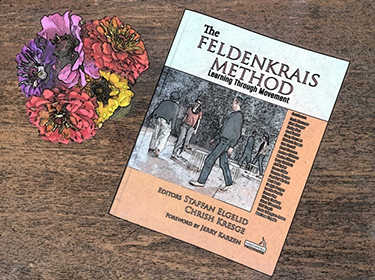
Summer reading

I couldn’t wait to tear open the envelope. The Feldenkrais Method: Learning Through Movement, edited by two fine colleagues, Chrish Kresge and Staffan Elgelid, had finally arrived.
Consisting of 25 insightful and thought-provoking chapters, the book provides a comprehensive overview of the history, theory, and diverse contemporary applications of Moshe’s method. To give you a sense of the scope of topics covered, here’s a list of the chapter titles and their authors:
Part 1
- Who Was Moshe Feldenkrais?
Chrish Kresge and Elinor Silverstein
- Feldenkrais® as a System of Learning
Jeff Haller - The Importance of the Brain, Nervous System, and Body in Learning
Susan Hillier - Training Feldenkrais® Teachers
Larry Goldfarb - Function, Differentiation, and Integration
Lisa Burrell - The Feldenkrais Method®, Science, and Spirituality: A Historical Perspective
Matthew Zepelin
Part 2
- Moshe Dō: From Martial Art to Feldenkrais® Art
Moti Nativ - Anat Baniel Method® NeuroMovement®: Transforming the Lives of Children with Special Needs
Anat Baniel - Integrating the Feldenkrais Method® into Scholastic Learning
Eilat Almagor and Dorit Aharonov - Movement Intelligence® for Bone Health and Graceful Aging
Ruthy Alon - My Path from Feldenkrais® to the Tellington TTouch Method®
Linda Tellington-Jones - Stress, Anxiety, and Trauma
Donna Ray - Creativity: Thinking While Moving
Lavinia Plonka - Feldenkrais® for Music and Voice
A — Behind the Music Andrew Gibbons
B — Voice/Singing Marina Gilman - The Feldenkrais Method® and Dance
Paul Pui Wo Lee - The Feldenkrais Method® and a Theater of Enaction
Thomas Kampe - Moving to Learn, Training to Win
Dwight Pargee - Feldenkrais® to Enhance Yoga
Staffan Elgelid - Somatic Education: Feldenkrais® and Pilates
Stacy Barrows and Matthew Barrows
Part 3
- The Feldenkrais Method® in Orthopedics
Staffan Elgelid - The Feldenkrais Method® in the Rehabilitation of Neurological Conditions
Karol Connors - Pain and Curiosity
Deborah Bowes - Practical Maturity: The Feldenkrais Method® and Human Development
Cliff Smyth - A Future Vision of the Feldenkrais Method®
Chrish Kresge
When Staffan and Chrish contacted me about writing a chapter, I was doubly honored: first, to be part of this esteemed group of leading teachers and thinkers and, second, to be asked to address the training of Feldenkrais teachers. It turned out that the most challenging part of the assignment was figuring out how to distill the relevant and crucial information down to a mere 3,000 words. Chrish proved to be an excellent editor, working closely with me to help craft my contribution. She was exceptionally kind and patient when I was going through radiation and chemo, for which I am so grateful and without which I wouldn’t have been able to finish my contribution.
Cracking the book open and leafing through chapters, I read Jerry Karzen’s sweet remembrance of Moshe. I recognized many of the authors by reputation or through knowing them personally. The range of age, nationality, background, conceptual approach, etc., is impressive. So many intriguing teachers and topics, most of whom also contributed the recording of an Awareness Through Movement lesson (accessible online).
When I saw Ruthy Alon’s chapter, I realized it might well be the last thing she wrote before leaving us earlier this year.
The title of Moti Nativ’s chapter, which is about the martial arts roots of the method, is “Moshe Dō,” meaning the way of Moshe. In a flash, I remembered the first time I’d heard that turn of phrase. In the early days in the US, Moshe wasn’t that keen on people promulgating his work. Instead, he encouraged those in the San Francisco teacher training to take what they learned from him into their existing professions or practices. The way I heard the story, two of them, Dub Leigh and Betty Fuller, tried, unsuccessfully, to talk Moshe into using Moshe Dō as the name of his method.
Point being, many sections caught my eye. What a richness of options! I couldn’t choose which to read first. That’s when I decided to set the publication aside to take my time and read it on vacation next month.
To get your copy of The Feldenkrais Method: Learning Through Movement, please click here to go to the Handspring Press website. You can save 10% by using this coupon code when you check out: fbmb10.
Your thoughts?
Please let us know your perspective! Add your comments, reactions, suggestions, ideas, etc., by first logging in to your Mind in Motion account and then clicking here.
Commenting is only available to the Mind in Motion Online community.
Join in by getting your free account, which gives you access to the e-book edition of Articulating Changes (Larry's now-classic Master's thesis), ATM® lessons, and more — all at no charge whatsoever.
To find out more and sign up, please click here.
Please share this blog post
 This work is licensed under a Creative Commons Attribution-ShareAlike 4.0 International License
This work is licensed under a Creative Commons Attribution-ShareAlike 4.0 International License
This blog may contain one or more affiliate links. When you click on a link and then make a purchase, Mind in Motion receives a payment. Please note that we only link to products we believe in and services that we support. You can learn more about how affiliate links work and why we use them here


Responses